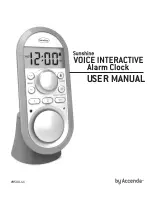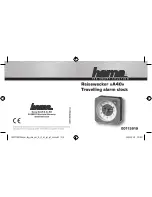
F300-10-00 8 I56-0020-004R
©2003 Fire•Lite Alarms
[12] Model D350P Air Duct Smoke Detector Specifications
Operating Voltage Range 15 to 32 VDC
Standby Current 300
µ
A @ 24 VDC (one communication every 5 seconds with LED blink
enabled)
Operating Temperature +32° to +131°F (0° to +55°C)
Storage Temperature –22° to +158°F (–30° to +70°C)
Humidity Range 10% to 93% (non-condensing)
Air Velocity 500 to 4000 ft/min (2.54 to 20.32 m/sec)
Dimensions 14
3
⁄
8
″
L x 5
1
⁄
2
″
W x 2
3
⁄
4
″
D (37 cm L x 14 cm W x 7 cm D)
Programming Specifications/Requirements for Intelligent System Control Panels
There are a limited number of devices that can have their LEDs programmed to illuminate. The actual number of devices
is determined by the control panel and its ability to supply LED current. Refer to the Control Panel Installation Manual for
details.
Accessories
Part No.
Remote LED
RA400Z
Magnetic Remote Test
RTS451
Key-Activated Remote Test
RTS451KEY
Replacement Filters
F36-09-11
Replacement Test Magnet
M02-04-00
Replacement Photo Insect Screen
S08-39-01
Replacement End Cap for Plastic Sampling Tube
P48-61-00
Replacement End Cap for Metal Sampling Tubes
P48-21-00
Replacement Photoelectric Sensor Board
A5053FL
Replacement Power Board (w/o relay)
A5067
FCC Statement
This device complies with part 15 of the FCC Rules. Operation is subject to the following two conditions: (1) This device may not cause harmful interference, and (2) this
device must accept any interference received, including interference that may cause undesired operation.
Note: This equipment has been tested and found to comply with the limits for a Class B digital device, pursuant to Part 15 of the FCC Rules. These limits are designed to
provide reasonable protection against harmful interference in a residential installation. This equipment generates, uses and can radiate radio frequency energy and,
if not installed and used in accordance with the instructions, may cause harmful interference to radio communications. However, there is no guarantee that interference
will not occur in a particular installation. If this equipment does cause harmful interference to radio or television reception, which can be determined by turning the
equip
ment off and on, the user is encouraged to try to correct the interference by one or more of the following measures:
– Reorient or relocate the receiving antenna.
– Increase the separation between the equipment and receiver.
– Connect the equipment into an outlet on a circuit different from that to which the receiver is connected.
– Consult the dealer or an experienced radio/TV technician for help.
To keep your equipment in excellent working order, ongoing maintenance is required per the manufacturer’s recommendations and UL and NFPA standards. At a minimum,
the requirements of Chapter 7 of NFPA 72, the National Fire Alarm Code, shall be followed. A preventative maintenance agreement should be arranged through the local
manufacturer’s representative. Though smoke detectors are designed for long life, they may fail at any time. Any smoke detector, fire alarm equipment, or any component
of that system which fails shall be repaired or replaced as soon as possible.
F300-10-00 1 I56-0020-004R
Fire•Lite Alarms, Inc., One Fire-Lite Place, Northford, CT 06472, 203-484-7161
Before installing detectors, please thoroughly read the NEMA
Guide for Proper Use of Smoke Detectors in Duct
Applications,
which provides detailed information on detector spacing, placement, zoning, wiring, and special applica-
tions. Copies of this manual are available from NEMA (National Electrical Manufacturers Association, 2101 L Street NW,
Washington, DC 20037). NFPA Standards 72 and 90A should also be referenced for detailed information.
NOTICE:
This manual shall be left with the owner/user of this equipment.
IMPORTANT:
This detector must be tested and maintained regularly following NFPA 72 requirements. The detector
should be cleaned at least once a year.
GENERAL DESCRIPTION
An HVAC system supplies conditioned air to virtually every area of a building. Smoke introduced into this air duct system
is distributed to the entire building. Smoke detectors designed for use in air duct systems are used to sense the pres-
ence of smoke in the duct.
The D350P air duct smoke detector is a photoelectric detector. This smoke detection method combines with an efficient
housing design that samples air passing through a duct and allows detection of a developing hazardous condition. When
sufficient smoke is sensed, an alarm signal is initiated at the fire control panel monitoring the detector, and appropriate
action can be taken to shut off fans, blowers and change over air handling systems, etc. This can prevent the distribution
or it can isolate toxic smoke and fire gases throughout the areas served by the duct system.
Two LEDs on each detector may illuminate, if programmed by the system control panel, to provide a local alarm indica-
tion. There is also a remote alarm output for use with auxiliary devices. The D350P has remote test capability with the
RTS451/RTS451KEY Remote Test Station.
CONTENTS OF THE DUCT SMOKE DETECTOR HOUSING KIT
The D350P Duct Smoke Detector consists of the following items: (See Figure 1.)
D350P INTELLIGENT PHOTOELECTRONIC DUCT SMOKE DETECTOR
INSTALLATION AND MAINTENANCE INSTRUCTIONS
Figure 1: Exploded View Of Duct Smoke Detector Components
NOTE:
For ducts over 1
1
⁄
2
feet, longer sampling tubes must be ordered to complete the installation. They must be the
correct length for the width of the duct where they will be installed. See Table 1 on page 3 to determine the
sampling tube required for different duct widths.
1. Complete duct smoke detector
assembly with sensor
2. Two #10 x 11/4” sheet metal mounting
screws
3. Two sampling tube filters
4. One test magnet
5. Drilling template
6. Two foam gaskets
7. Four #6-self tapping mounting screws
for the sampling tube and optional
exhaust tube extension
8. One sampling tube end cap
9. One plastic sampling tube
10. One #8 self-tapping screw for plastic
sampling tube
NOTE: A detector sensor board DOES
NOT need to be ordered separately.
Contents Of The Duct
Smoke Detector
Please refer to insert for the Limitations of Fire Alarm Systems
����
�������
������������
�������������
��������
�������
��������������
��������
�����
�������������
����������
�������
����
������������
�����
�����������
��������������
��������������
������
H0106-00






















